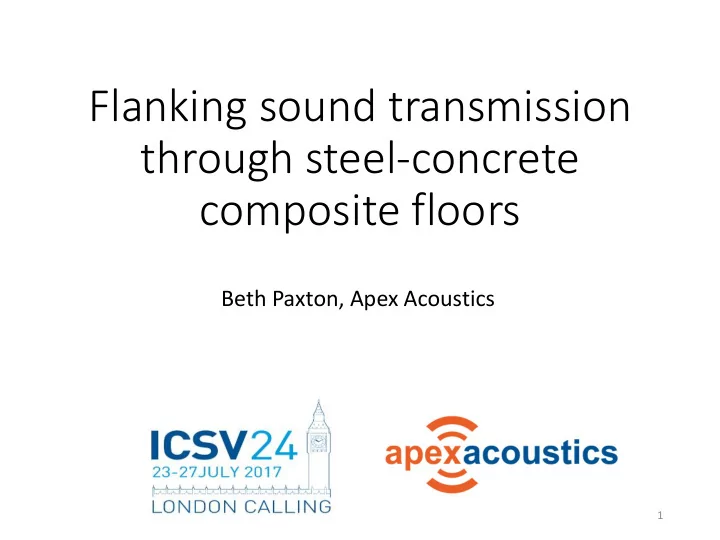

Flanking sound transmission through steel-concrete composite floors Beth Paxton, Apex Acoustics 1
Introduction • Popular construction type in multi-residential developments • Quick and simple method of construction • Minimum amount of building materials used • Lightweight partitions built off concrete slab 2
The problem • Flanking transmission – continuous concrete floors • Guidance indicates floating floors • Building Regulations performance achieved between hotel bedrooms at Site A Object : Reliable model to predict sound transmission 3
EN 12354-1 • Bastian software used to predict sound transmission • Transmission through each flanking path calculated and the contributions from each path combined. • Floor flanking path sound reduction index simplifies to: 𝑇 𝑡 𝑆 𝑗𝑘 = 𝑆 𝑡𝑗𝑢𝑣 + 𝐸 𝑤,𝑗𝑘,𝑡𝑗𝑢𝑣 + 10lg 𝑇 𝑗 𝑇 𝑘 dB 4
Verification of model at Site A 70 70 • 13 wall tests undertaken at Site A 60 60 • Average of measured Standardised level difference, D nT , dB Standardised level difference, D nT , dB tests compared with 50 50 Bastian prediction • Sound insulation 40 40 underpredicted at low 30 30 frequency 20 20 100 125 160 200 250 315 400 500 630 800 1000 1250 1600 2000 2500 3150 100 125 160 200 250 315 400 500 630 800 1000 1250 1600 2000 2500 3150 Frequency, Hz Frequency, Hz Test 1 Test 2 Test 3 Prediction - total Measured average Test 4 Test 5 Test 6 Test 7 Test 8 Test 9 Test 10 Test 11 Test 12 5 Test 13 Measured average
Site B Measurements – R situ • R’ measured for 7 floors, 3 80 tests disregarded due to 70 Sound reduction index R, R', dB notable flanking sound 60 • Underprediction of sound insulation at low frequency 50 40 30 20 100 160 250 400 630 1000 1600 2500 Frequency, Hz Average measured R' Bastian Rsitu Bastian R Insul R 6
Site B Measurements – 𝐸 𝑤,𝑗𝑘,𝑡𝑗𝑢𝑣 • 𝐸 𝑤,𝑗𝑘,𝑡𝑗𝑢𝑣 measured between two pairs of rooms • Measured values significantly higher than expected 10 Measured Direction-averaged velocity level 9 Bastian 8 7 difference, dB 6 5 4 3 2 1 0 100 125 160 200 250 315 400 500 630 800 1000 1250 1600 2000 2500 3150 Frequency, Hz 7
Updated predictions – Site B 80 • Average of 4 wall tests Standardised level difference D nT , dB compared with predictions 70 • Use of measured R situ 60 improved the shape of the curve 50 • Best prediction used 40 measured R situ and 𝐸 𝑤,𝑗𝑘,𝑡𝑗𝑢𝑣 30 from Bastian as input data 100 125 160 200 250 315 400 500 630 800 1000 1250 1600 2000 2500 3150 Frequency, Hz Measured average Prediction - Floor: Bastian, Dv,ij: Bastian Prediction - Floor: Bastian, Dv,ij: Measured Prediction - Floor: Measured, Dv,ij: Bastian Prediction - Floor: Measured, Dv,ij: Measured 8
Updated predictions – Site B 80 • Low frequency behaviour Standardised level difference D nT , dB very closely predicted 70 • Floor flanking dominates 60 across most of the relevant frequency range 50 • On-site degradation of wall 40 performance expected 30 100 160 250 400 630 1000 1600 2500 Frequency, Hz Measured average Prediction - total Prediction - direct-direct Prediction floor-floor 9
Updated predictions – Site A 80 • Measured R situ corrected for Standardised level difference D nT , dB 70 mass of concrete • 𝐸 𝑤,𝑗𝑘,𝑡𝑗𝑢𝑣 taken from Bastian 60 • Improved prediction at low 50 frequency 40 • Underprediction of sound insulation at high frequency 30 20 100 160 250 400 630 1000 1600 2500 Frequency, Hz Measured average Prediction - direct-direct Prediction floor-floor Prediction - total Initial Bastian prediction 10
Conclusions • More accurate prediction enables more efficient designs • Justification for omitting floating floors • More laboratory floor data required to further improve predictions 11
Recommend
More recommend